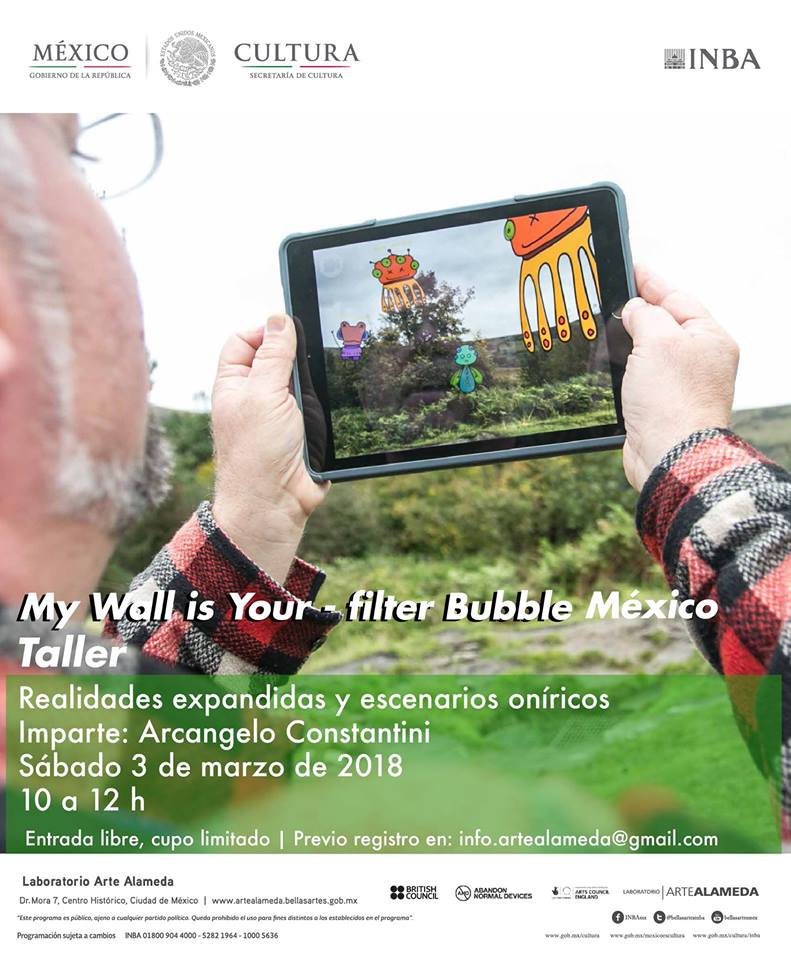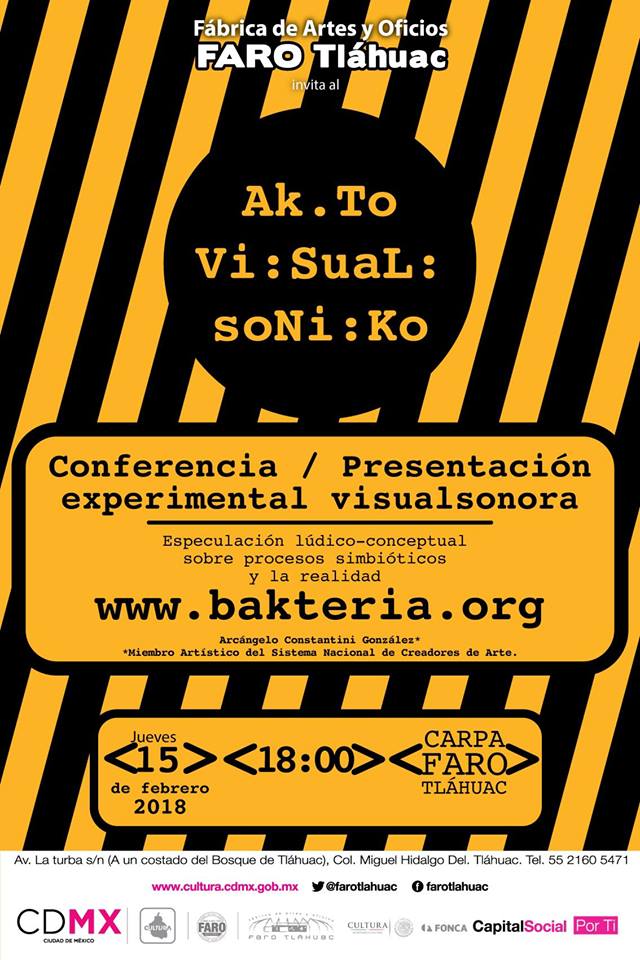ProXi-MA:M3NTe 3,4,5 de JuLio
S3rAš In:fe_KTAdo De MA_ner-A PerMANenT3 AL AdoPTAr
U-Na BAkTeria
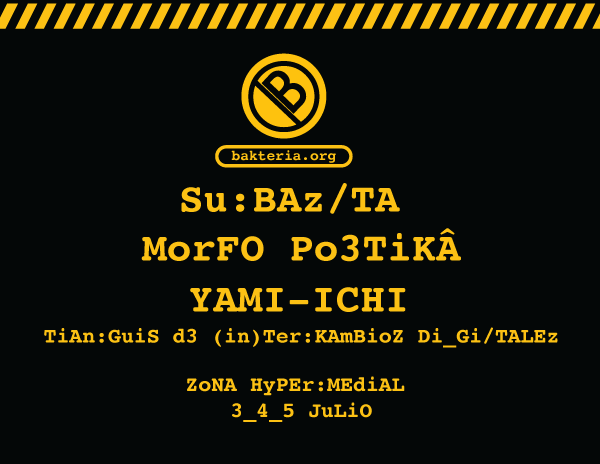
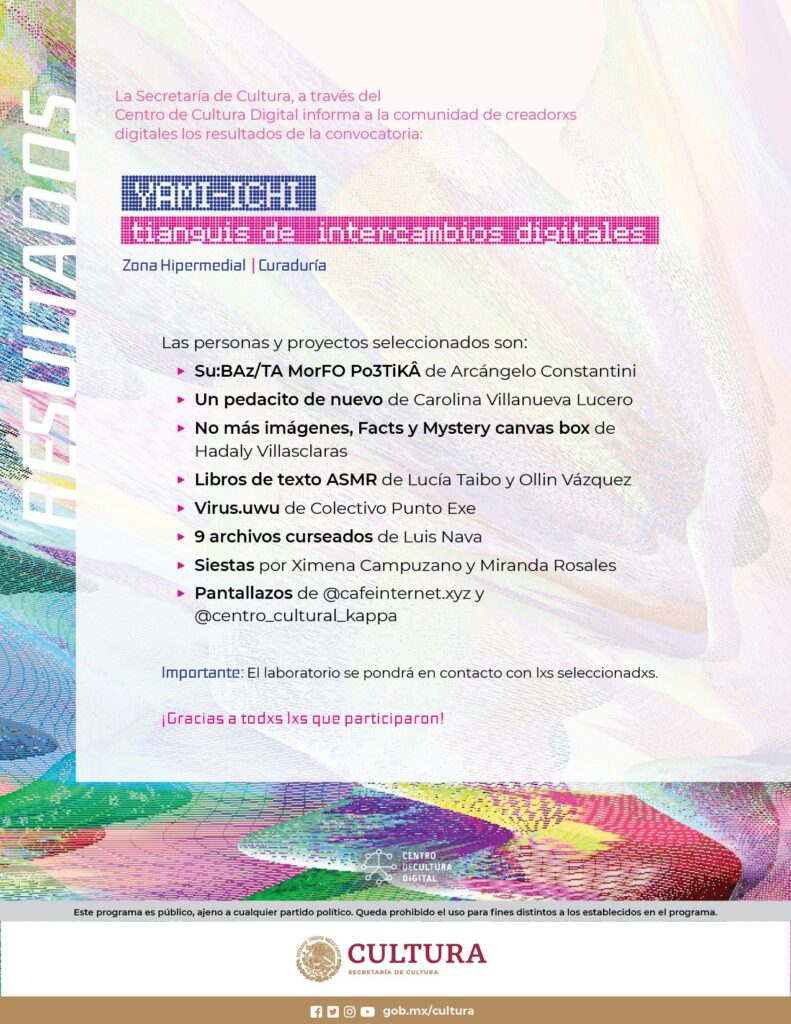
S3rAš In:fe_KTAdo De MA_ner-A PerMANenT3 AL AdoPTAr
U-Na BAkTeria


1: Bakteria.org
It is an experimental speculation on multiplicity, symbiosis, consciousness and the creative process of form in poiesis. An experiment on generative and expanded animated drawing, initiated by arcangelo constantini in 1997, when he developed a neuro-algorithm, which he uses as a creative process to draw improvised anthropomorphic organisms. Each drawing he creates is unique and unrepeatable, it emerges spontaneously at the moment of the stroke, and it is not preconceived before the moment of drawing. A neuro-algorithm in which a point is transformed into a line and from a flow of free strokes a unique organism emerges, an idea suggestive of Kandisnky’s Point and Line in the Plane
The spontaneous generation of life, is an old Aristotelian theory, in which it was proposed that life could arise spontaneously from inorganic compounds. This automatic drawing experiment is named Spontaneous Morphogenesis, more than the spontaneous generation of life, is the form, as a reference of life, which is spontaneously generated, in this practice of expanded drawing.
bakteria.org speculates on the concept of animation as the state of livelines and the origin of life. From each entity of the thousands of distinct characters been drawn, emanates an Anima, with its own essence. To address this flow of thoughts, the emergence of bakteria has been documented, with different media, to register the generation of the organism, and capture and share the flow of strokes in the drawing as a real time animation. the hypothetical MorphoGenesis Neuro Algorithm of generative drawing that creates form and character
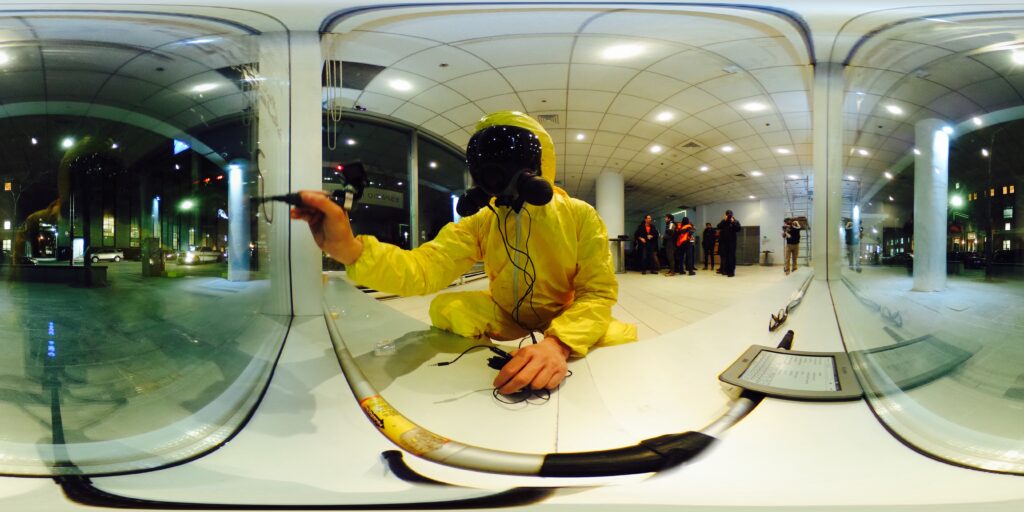
is a live audiovisual performance, For these graphic interventions we use a modified acrylic paint marker, the drawings are made directly on window panes, this marker has an integrated camera, that films with a subjective first person point of view and transmit it via wifi. One or two live coding sound artists are invited to program sound live, the video signal of the code and the signal of the marker are projected , live drawing and live coding sharing a metaphor on visual and sound algorithms, analog and digital, conscious and subconscious, objective and subjective, static and animated, invisible and visible, poetic and hypothetical, with sense and nonsense, at the drawing each Bakteria, they are named, these words are declamated using a vocoder and FM broadcast
this performance has been held in Espacio México Montreal Gallery , Museo de Arte Moderno in Mexico City , and Biblioteca Bicentenario In Chihuahua ,
http://www.bakteria.org/Vitrina/subjetiva/FAN/
http://www.bakteria.org/Vitrina/vitrinaweb/Session.html
all the process is registred to create subsecuent for internet and exhibit in place
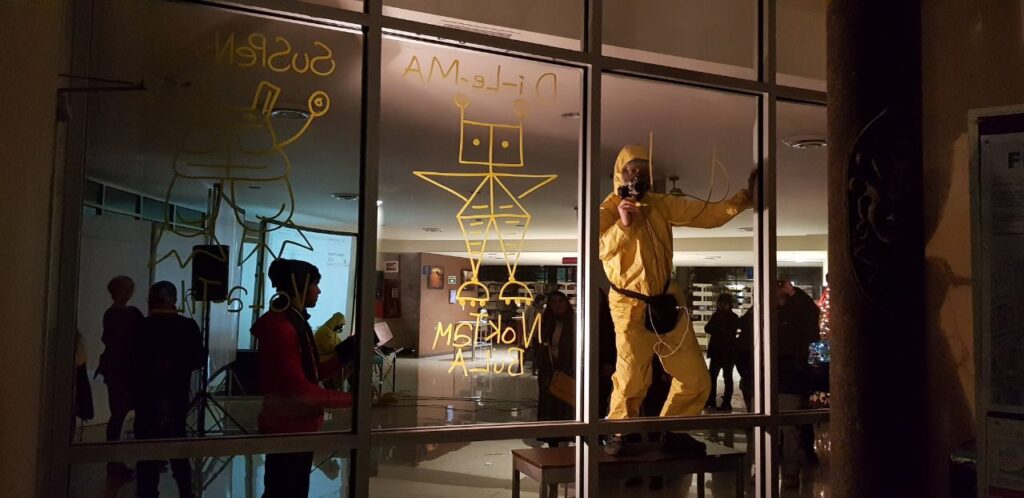
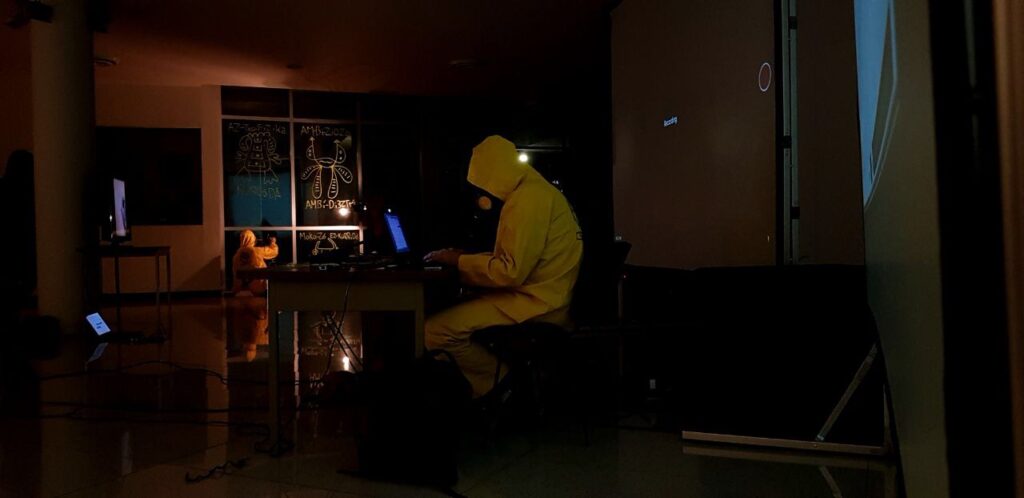
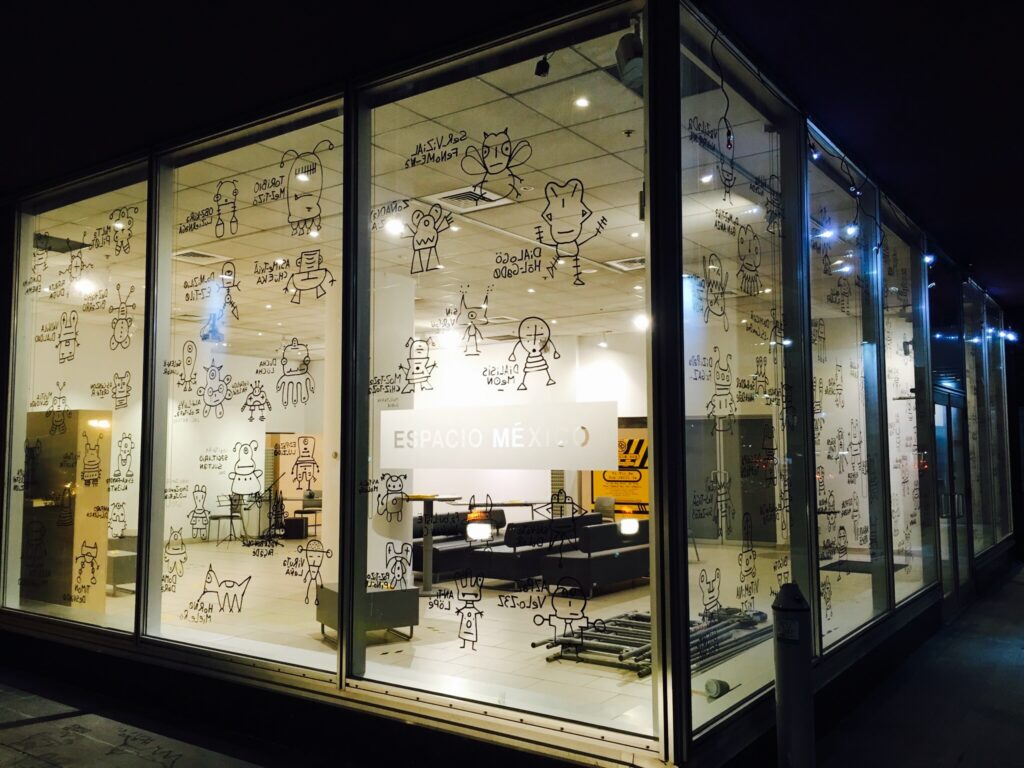
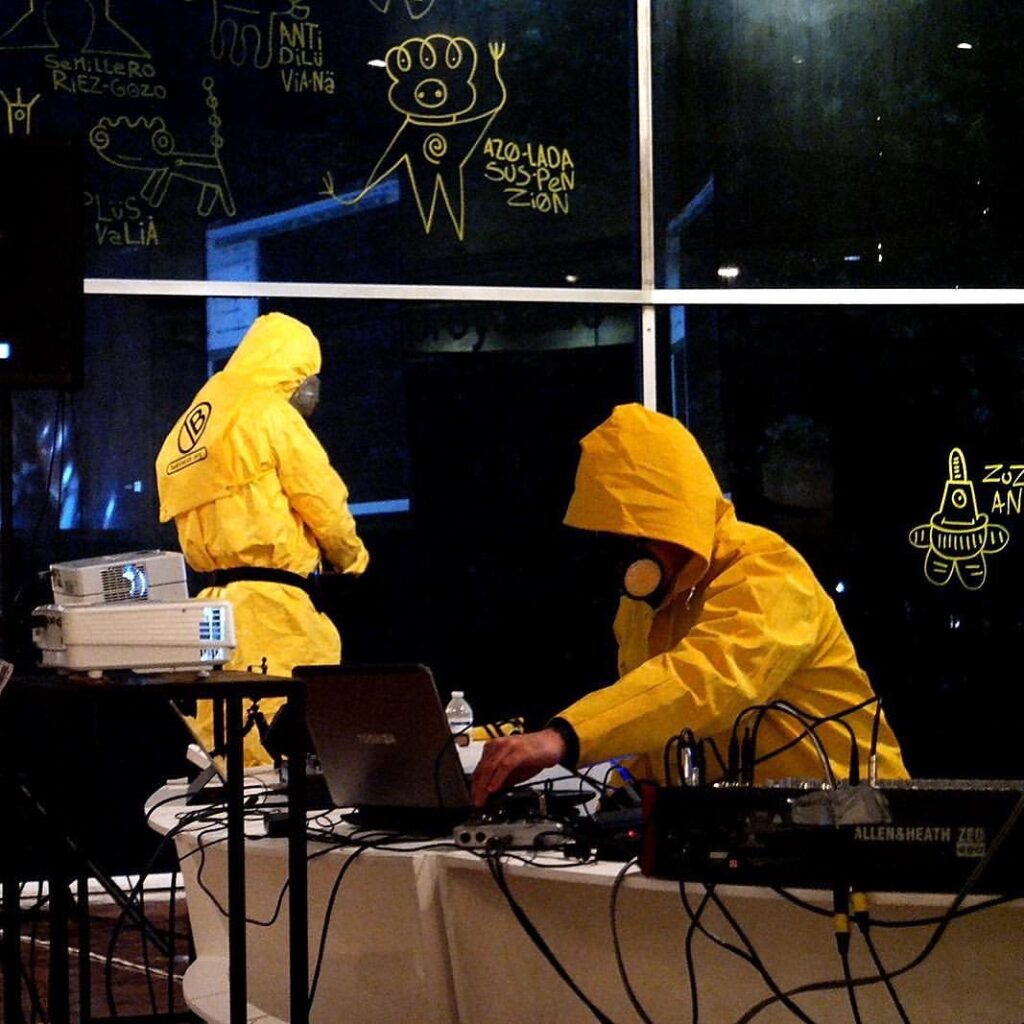
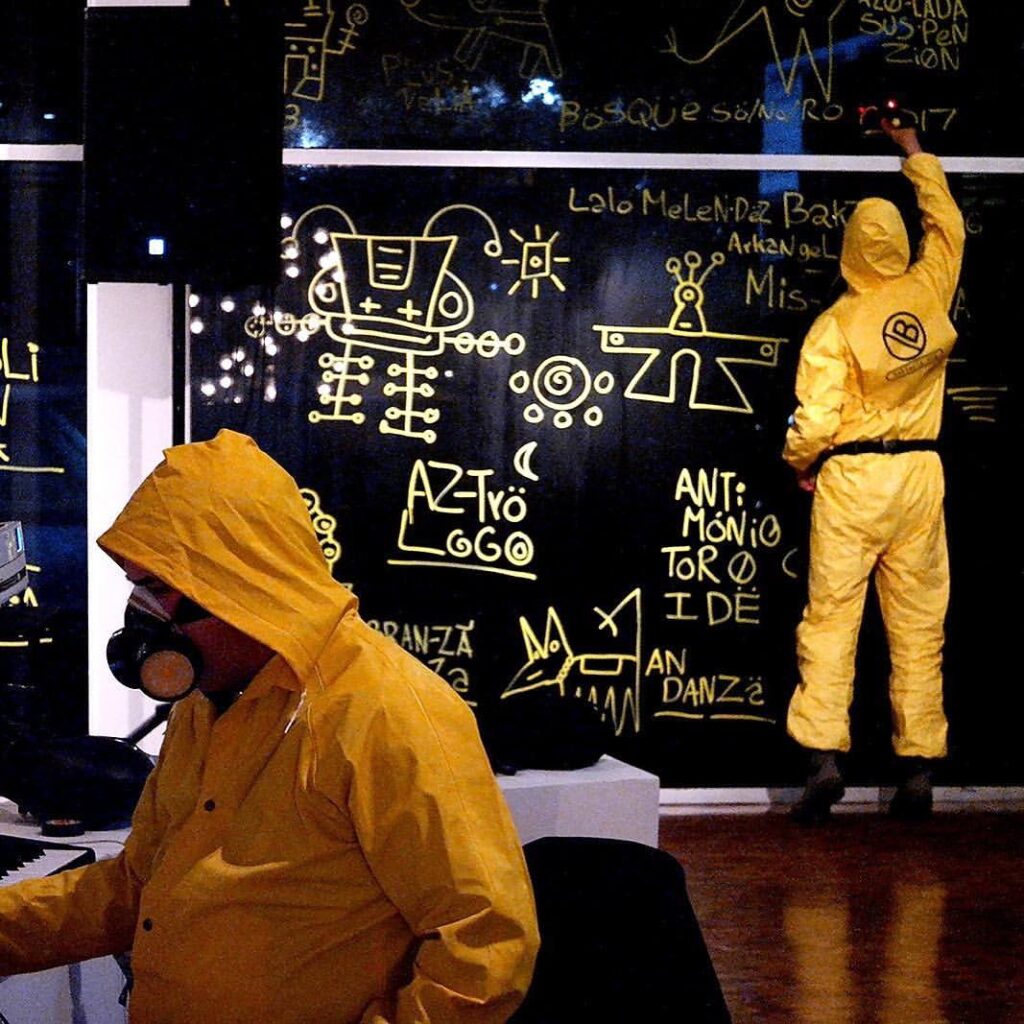
Hy_po[[the]]sis
Bacteria and Archae are simple and basic unicellular organisms of the prokaryote family, which in evolutionary, mutualistic and symbiotic processes gave rise to the eukaryotic multicellular organisms that evolved into all the biological forms and structures that have existed on the planet. From simple forms, complex forms emerged.
The human organism has its origin in this primordial soup and lives in endosymbiosis with the bacteria, as the microbiota forms a fundamental part of the metabolic processes, health, and emotions. In reality we are more bacteria than humans, since they are more numerous than the cells of our body, a multiplicity of diverse organisms form our microbiota without them we could not live.
The hologenome is an evolutionary hypothesis, in the body there are about eight million twenty-seven thousand genomes, of which only twenty-seven thousand are human, the other million pieces of information belong to all the microorganisms that inhabit the human body
The act of drawing bakteria, is to release the direct consciousness on the process, meditate on endosymbiosis, on the microorganisms that inhabit the body, on the conscience and the Self. At the moment of drawing, without entering in trance but like a medium, it release them to the paper, in the process they undergo an extreme mutation, from simple organisms they are anthropomorphized, taking an specific personality, they pass from a oniric state to a concrete medium, the paper, to later migrate on a digital process to the web. as interactive visual sonic micro poetic systems, to infect the mind of the users.
Morphology is the studies of both biological and design forms and structures, in the same way, in linguistics, it studies the structure of words.
In the post-war Dadaist movement, led by the poet Andre Breton, automatic writing was developed, as a poetic process in which the conscious is freed and the subconscious is allowed to flow when writing texts that become coherent after the gesture, as well as experimenting with the subconscious mind’s processes using automatic drawing.
The aesthetics of the Bakteria Neuro Algorithm is a local biota that is nourished by the universal trends, its aesthetics is a mixture of morphological mutations without being direct references of some of the traces of the Mesoamerican cultures with microdose of oriental and western aesthetics, the Neuro Algorithm maintains an aesthetic coherence with an evolutionary trace
Since he began to draw Bakteria, in an unusual and empirical way, each one he draws is associated with words that undergo a lexical mutation, these words are spontaneous and arise at the moment of the trace.
Bakteria structures language as an organism that evolves, mutates, changes and transforms, with the advent of computer systems, an arsenal of ascii characters as symbols of the international phonetic alphabet, are in a disposition to be used to infect the grammar and to complex and aestheticize the lecture in a Morpho-poetic style.
Bakteria.org is part of an experimental practice in development since 1997, a constant experiment under a specific methodology. It has developed experimental hypotheses of speculation on the structures of reality.
At the beginning, Bakteria was located in the net art repository unosyunosyunosceros.com, which is a site that speculates on the perception of space and the tangible and intangible aspects of reality, with visual and sound speculative experiments on three states of perception ( Oniric-Concrete-Digital). Then the project emigrate to its own domain www.bakteria.org
The main speculation is on the perception of the mind in the oniric realm, a space of subjectivity and immateriality, the concrete as the material and objective, and the new materiality of digital environments.
Bakteria.org is fundamental in this continuous experiment of speculation about reality, a process that starts in the oniric environment (derived from biological and metabolic processes) that lands in a concrete medium (paper) to be derived into digital interactive systems (the network) and to infect by means of the interaction the mind of the users (oniric) returning to the original and initial flow of the project.
The sound is a fundamental part of the project, at the beginning as a public visual-sonic and performative activity. Bakteria has collaborated with a diversity of sound artists, among them, ÁLvaro Ruiz, Manrico Montero, Arthur Henry Fork, Israel Martinez, Juan jose Rivas, Mario De vega, among others
In February 2000, VisuaSonico performed its first live act at the Carrillo Gil Museum of Art, which initiated a stage of public actions that took place in different cities: Montreal, Buenos Aires, Lima, Seoul, Kyoto, Rotterdam, Amsterdam, Dortmund, London, Puebla, Monterrey, Oaxaca, among others.
It was developed exponentially by obtaining the support of the National System of Artistic Creators FONCA
Thousands of different organisms have been realized to this date.
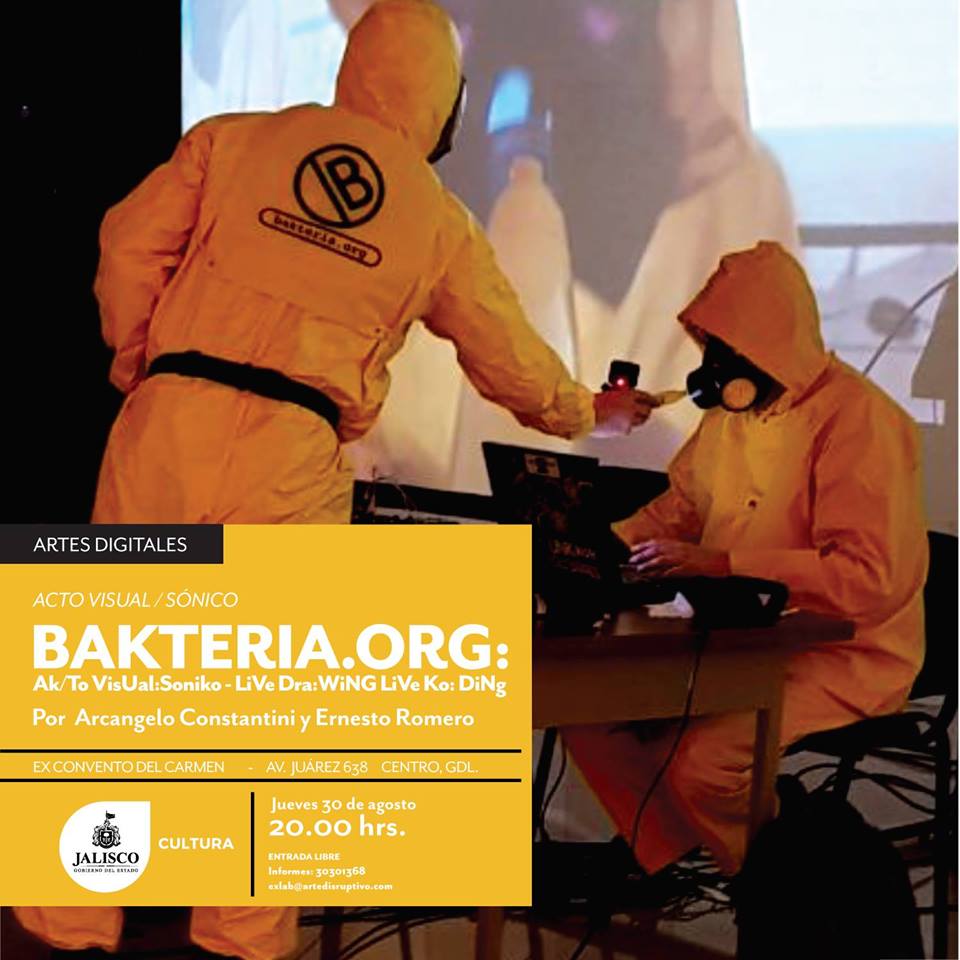
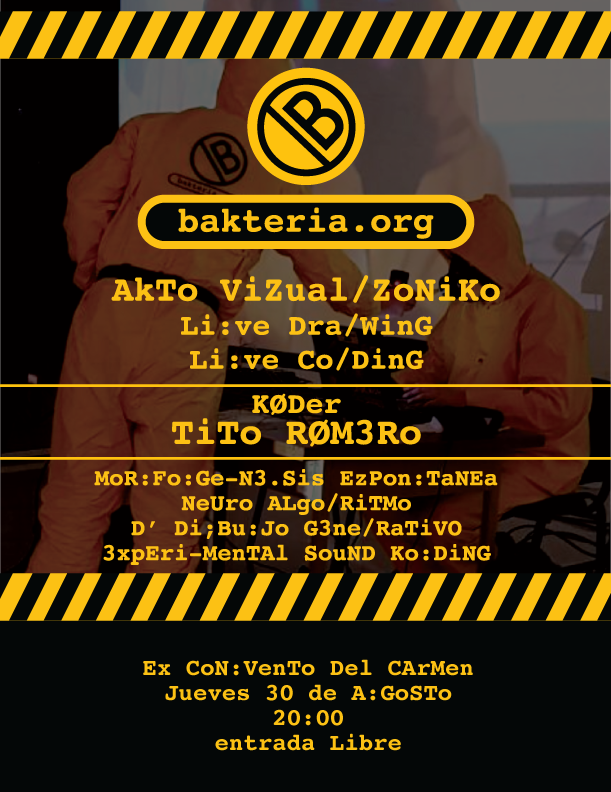
La InfLu:EnZiA d3 NuesTrOz MiKro:BioZ InteZ_Ti<NaLeZ 3n NueZTra E.Vo:LuZioN KoMo 3z:PeZi3
Una investigación reciente sugiere que la microbiota de un anfitrión biológico puede guiar su evolución hacia nuevas direcciones.
Los científicos son cada vez más conscientes de la actividad beneficiosa para nuestra salud y bienestar que ejercen algunos microbios del intestino y de otras partes del cuerpo, pero un biólogo de la Universidad de California, en Berkeley, Estados Unidos, se pregunta si estos microbios, nuestra microbiota, podrían también haber jugado un papel importante a la hora de dar forma a quiénes somos, al influir en la evolución.
Hay pruebas de que la interdependencia entre los animales y sus simbiontes (los organismos, normalmente bacterias, que viven dentro o sobre sus anfitriones sin poner en riesgo las vidas de estos bajo condiciones normales) tiene consecuencias para la evolución de ambos. Pero Michael Shapira, profesor de biología integradora de la Universidad de California en Berkeley, Estados Unidos, cree que las diversas comunidades microbianas que albergamos tienen un efecto más profundo, interviniendo notablemente en la evolución mediante una colaboración íntima por la supervivencia.
Shapira, quien estudia los microbios del intestino del gusano nematodo C. elegans, ha revisado evidencias que demuestran cómo afectan y contribuyen las microbiotas a la evolución del anfitrión, ya sea evolucionando junto a él o bien interviniendo en momentos críticos para ayudarle a adaptarse a un nuevo reto medioambiental.
[Img #35447]
Como ilustra este esquema, todos tenemos microbios en nuestros intestinos: nuestra microbiota. Michael Shapira propone que no todos los microbios son iguales. Algunos, los principales, son importantes para nuestra existencia y evolución, y podrían incluso ser pasados a nuestros descendientes. Además, está disponible una reserva flexible de microbios (miembros de los cuales pueden ser intercambiados por otros similares en el entorno) para ayudar en nuestra supervivencia y adaptación frente a los cambios medioambientales. (Imagen: Michael Shapira/UC Berkeley)
Estos ejemplos, afirma, refuerzan el concepto relativamente reciente del hologenoma, un término que se refiere a los genomas del anfitrión y de sus microbios como un todo, abarcando quizás a miles de diferentes tipos de bacterias sobre la piel, en el intestino e incluso en los órganos reproductores. En su estudio reciente, Shapira respalda la noción propuesta en 2008 por investigadores de la Universidad de Tel Aviv, en Israel, de que la evolución puede actuar sobre el hologenoma, en vez de sobre los genomas del anfitrión y de su microbiota por separado. Esto implica que a medida que el anfitrión evoluciona para adaptarse a un entorno cambiante, su microbiota juega un papel crítico en la dirección y participación en esa evolución.
Información adicional
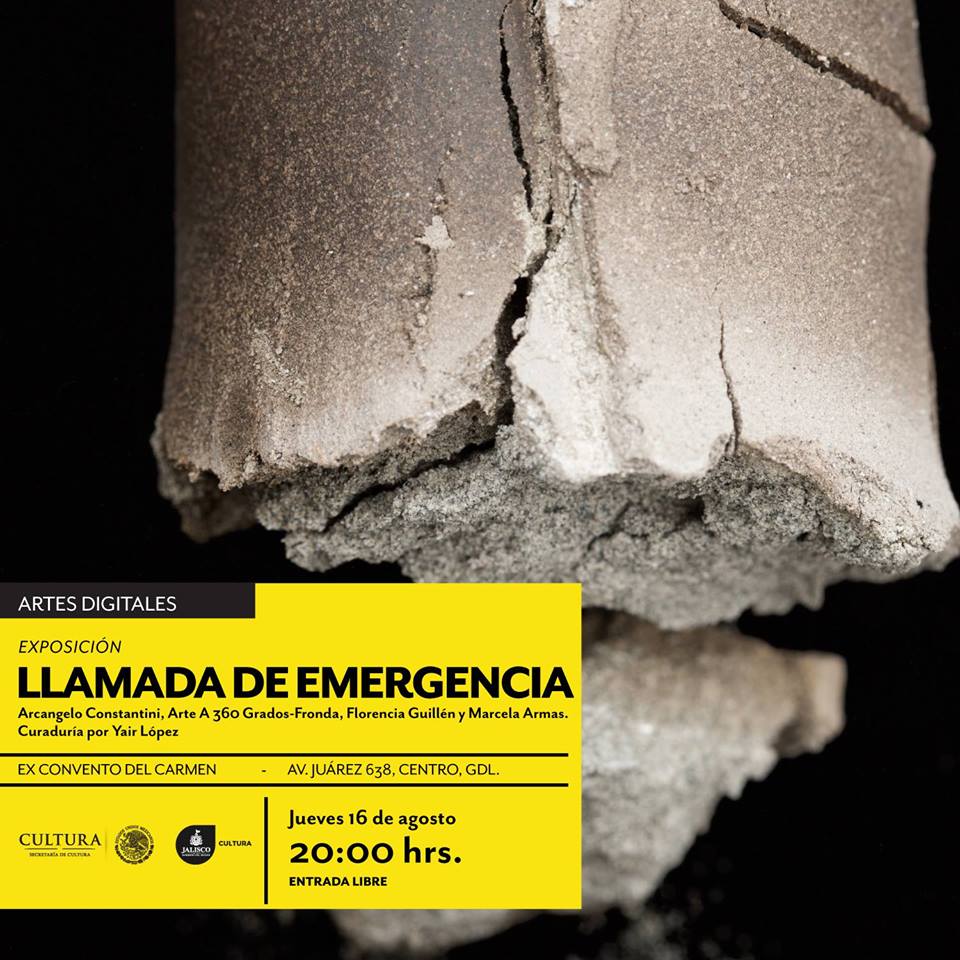
MoN/Ta:J3 de
Pe/Tri Di:SH AuG/MenteD R3a4L/iTy
LLa_MA/Da de 3mer:GEnZia :
Está exhibición es una llamada de emergencia, una llamada desesperada de cuatro artistas mexicanos que son puestos en un mismo sitio por voluntad y determinismo: Arcangelo Constantini, Arte A 360 Grados-Fronda, Florencia Guillén y Marcela Armas. Exposición bajo la Curaduría de Yair López.
Los esperamos este jueves, 16 de agosto a la inauguración a partir de las 20:00 horas en las salas 1 y 2 del Ex Convento del Carmen
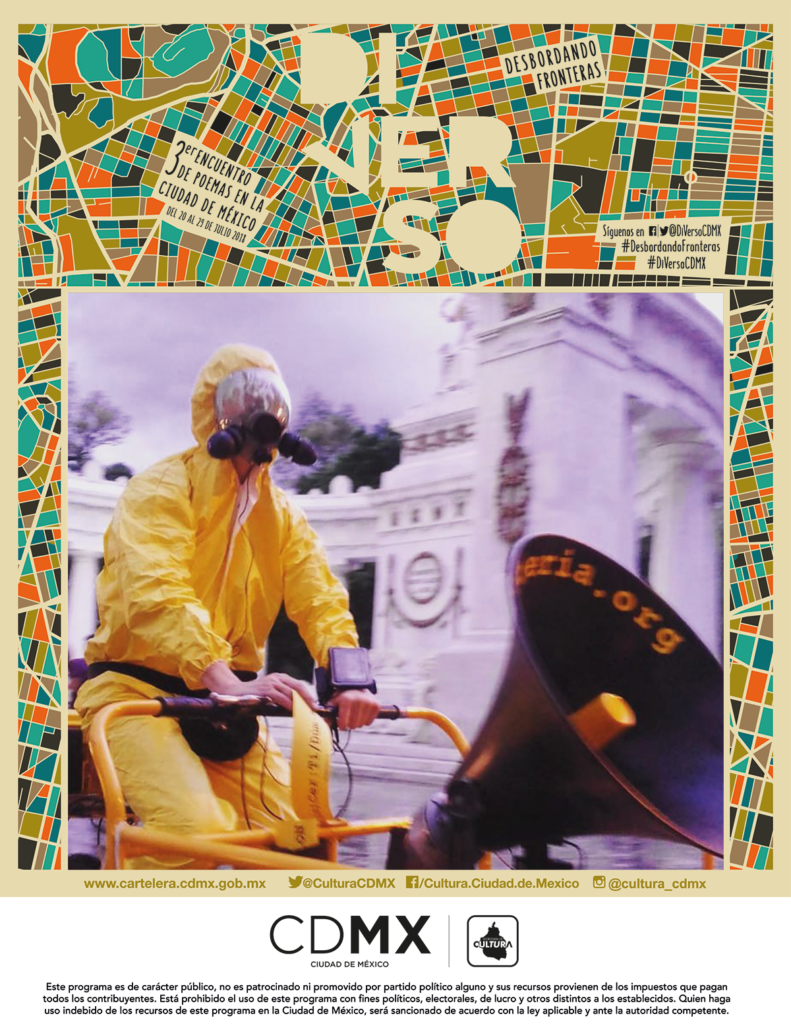
La Morfología es tanto el estudio de las formas y estructuras biológicas como las del diseño De la misma manera en lingüística estudia la estructura de las palabras. Los dadaístas desarrollaron la escritura automática, como un proceso poético en el que liberan al consciente y dejan fluir al subconsciente en la escritura de textos, Bakteria estructura a el lenguaje como un organismo que evoluciona, muta cambia y se transforma, con el advenimiento de los sistemas computacionales, un arsenal de caracteres ascii, simbolos del alfabeto fonético están en disposición de usarse para infectar la gramática y estetizar la lectura
Un acto morfo poético de infección gramatical a palabras, que surgen del subconsciente como un proceso creativo no programado y sin sentido inmediato para la conciencia, son re-escritas para construir micropoemas léxicos, estas serán impresas en papel amarillo mezcladas y seleccionadas al azar Usando un Vocoder serán declamadas las palabras infectadas, la re-estructura morfológica es la pauta de lectura fonetica La lectura será en tiempo real circulando en un triciclo con un sistema de amplificación por perifoneo , el triciklo será un sistema de propagación léxica y poética
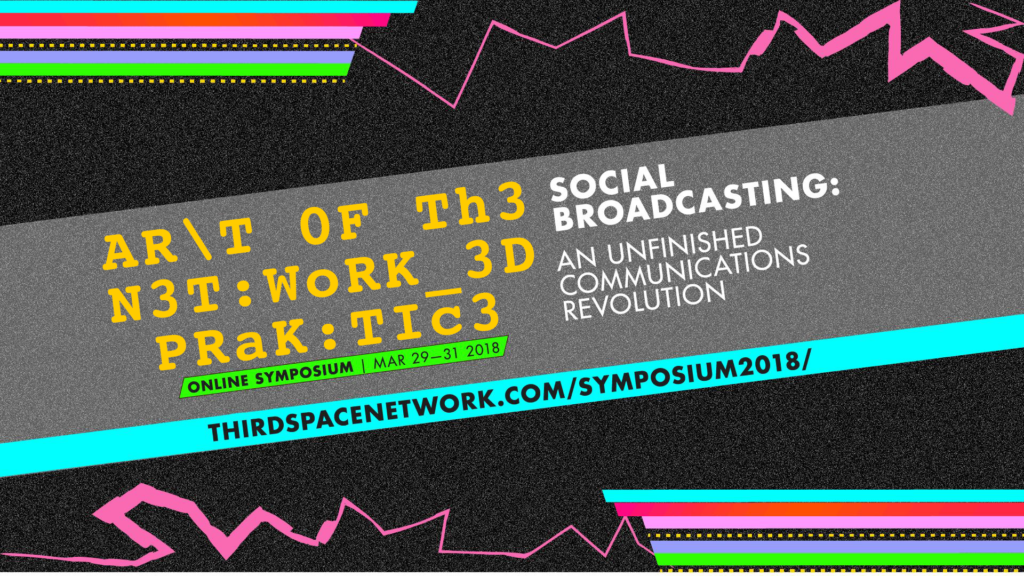
THE ART OF THE NETWORKED PRACTICE ONLINE SYMPOSIUM
A three-day international gathering presenting keynotes, live Internet performances, and global roundtable discussions.
THE ART OF THE NETWORKED PRACTICE ONLINE SYMPOSIUM is a collaboration between the School of Art, Design & Media at
Nanyang Technological University (Singapore); LASALLE College of the Arts (Singapore); & The School of the Art Institute of Chicago, Department of Performance (US)
MARCH 29 – MARCH 31, 2018
https://
LOGIN
All events are online via Adobe Connect Web conference
https://
Download Adobe Connect Application if prompted
Select “Guest,” type your name, “Enter Room”
ONLINE REGISTRATION
http://bit.ly/
For event details, e-mailings and symposium participation
SYMPOSIUM CHAIR
Randall Packer, Associate Professor of Networked Art, Nanyang Technological University, School of Art, Design and Media, Singapore
KEYNOTES:
— Maria Chatzichristodoulou, Associate Professor in Performance and New Media, London South Bank University, UK
— Matt Adams, Blast Theory Co-founder, UK
LIVE NETWORKED PERFORMANCES:
— Online En-semble – Entanglement Training: Directed and performed by Annie Abrahams (FR) with Antye Greie (FI), Helen Varley Jamieson (DE), Soyung Lee (KR), Hương Ngô (US), Daniel Pinheiro (PT), Igor Stromajer (DE), and NTU students.
— igaies: Directed and performed by Jon Cates (US) with Roberto Sifuentes (US), Arcángelo Constantini (MX), Shawné Michaelain Holloway (US), 愛真 Janet Lin (US) & Paula Pinho Martins Nacif (UK) (XXXtraPrincess)
| ABOUT |
The Art of the Networked Practice Online Symposium is an international gathering presenting emerging research, artistic work, and technological innovation in the networked arts. Intended as a global and inclusive gathering, with no registration fees, the symposium unites local and remote speakers and audiences from all corners of the world via Webconferencing, bridging Singapore with an active international new media arts community that transcends geographic and cultural boundaries. The symposium demonstrated how networked space can be used to activate live performance and online artistic work, stimulate creative dialogue, and encourage open sharing of knowledge through an online global exchange.
| SOCIAL BROADCASTING: AN UNFINISHED COMMUNICATIONS REVOLUTION |
Media historian and activist Gene Youngblood signals the need for “a communications revolution… an alternative social world” that decentralizes the experience of the live broadcast through the creative work of collaborative communities. In response to Youngblood’s call-to-action, the Art of the Networked Practice Online Symposium will have as its theme, “Social Broadcasting: An Unfinished Communications Revolution.” Through the presentation of keynotes, live performances, and global roundtable discussions, the Art of the Networked Practice Online Symposium explores the concept of social broadcasting and its histories as a revolutionary shift from one-to-many streaming and performance modalities to distributed peer-to-peer interactions that creatively join artists and audiences in live, networked spaces.
| PROGRAM @ A GLANCE |
::: Day 1: Thursday, March 29,
School of Art, Design and Media, Nanyang Technological University, ADM 3-25, Singapore
7am-10am CDT-Chicago / 8am-11am EDT-East Coast / 1pm-4pm BST-UK /
2pm-5pm CEDT-Central Europe / 8pm-11pm SGT-Singapore
[Being & Connectedness in Telematic Space]
INTRODUCTIONS: Randall Packer, Symposium Chair; Vibeke Sorensen, Chair, School of Art, Design and Media, Nanyang Technological University, Singapore
KEYNOTE: Maria Chatzichristodoulou: Live Art and Telematics: The Promise of Internationalism
LIVE NETWORKED PERFORMANCE: Online En-semble – Entanglement Training directed by Annie Abrahams with collaborators
POST-PERFORMANCE GLOBAL ROUNDTABLE DISCUSSION: Moderated by Maria Chatzichristodoulou and Annie Abrahams with collaborators
::: Day 2: Friday, March 30
LASALLE College of the Arts, Block F, Level 3, Room F309, Singapore
7am-10am CDT-Chicago / 8am-11am EDT-East Coast / 1pm-4pm BST-UK /
2pm-5pm CEDT-Central Europe / 8pm-11pm SGT-Singapore
[Networking the Real and the Fictional]
INTRODUCTION: Steve Dixon, President, LASALLE College of the Arts, Singapore
KEYNOTE: Matt Adams: The Here, the Now, the Audience and the Spectator
GLOBAL ROUNDTABLE DISCUSSION: Moderated by Maria Chatzichristodoulou and Steve Dixon
::: Day 3: Saturday, March 31
School of the Art Institute of Chicago, Department of Performance, Performance Space 012 (Columbia Bldg basement)
10am-1pm CDT-Chicago / 11am-2pm EDT-East Coast / 4pm-7pm BST-UK /
5pm-8pm CEDT-Central Europe / 11pm-2am SGT-Singapore
[igaies – intimate glitches across internet errors]
INTRODUCTION: Jon Cates, Associate Professor Film, Video, and New Media, School of the Art Institute of Chicago, US
LIVE NETWORKED PERFORMANCE: igaies: directed by Jon Cates with collaborators
POST-PERFORMANCE GLOBAL ROUNDTABLE DISCUSSION: Moderated by Jon Cates and Roberto Sifuentes with collaborators
CLOSING: Randall Packer, Symposium Chair
See Program for specific times and details.
https://
| THIRD SPACE NETWORK |
The Third Space Network (3SN) is an Internet broadcast channel for the live media arts and creative dialogue. 3SN is a project of Randall Packer in conjunction with research at his studio in Washington, DC, and the School of Art, Design and Media, Nanyang Technological University in Singapore, where he is an Associate Professor of Networked Art.
https://
Twitter: @thirdspacenet
Facebook: https://www.facebook.com/
| SUPPORT |
The Art of the Networked Practice | Online Symposium is made possible through support from LASALLE College of the Arts, School of the Art Institute of Chicago, School of Art, Design and Media at Nanyang Technological University, along with grants from NTU CLASS, EdeX, and Startup Funds.
Este taller empoderará a los participantes a generar sus propios enlaces y conexiones a través de la colaboración. Abrirá paso al diálogo y buscará cerrar las grietas de comunicación que los filtros burbuja propician a través de la polarización de opiniones.
Registro previo: info.artealameda@gmail.com
British Council Mexico
#MWYFB #Tecnología #PensarenelInternet #Educación #LAA
